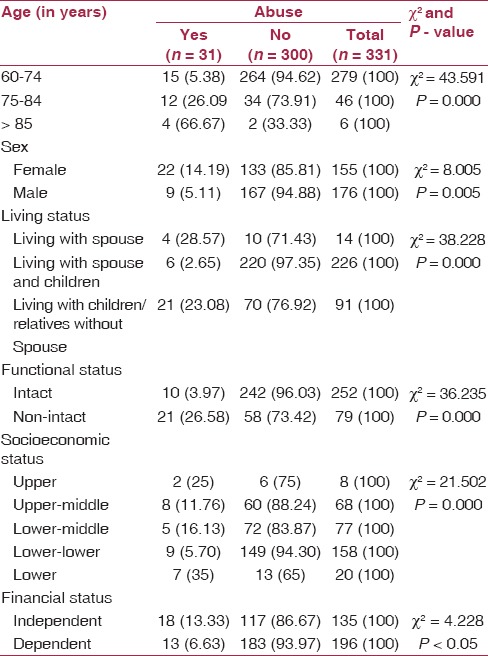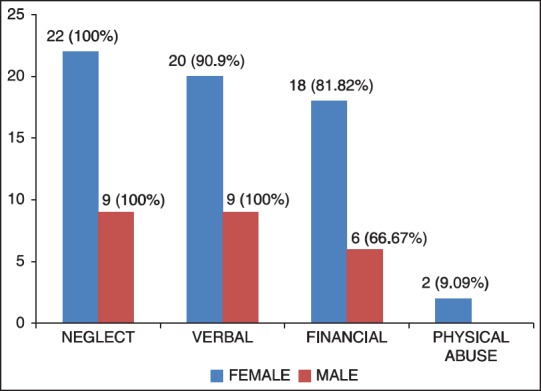Abstract
Background:
In spite of tremendous impact on health, elder abuse is still an underreported and unrecognized issue.
Objectives:
To assess the prevalence of abuse among community dwelling elderly and to identify the various risk factors.
Materials and Methods:
This community-based cross-sectional study was conducted in 10 randomly selected wards of Guwahati city. A total of 331 elderly (60 years and above) were interviewed. Abuse was screened by Hwalek-Sengstock Elder Abuse Screening Test (H-S EAST).
Results:
The study revealed 9.31% prevalence. Neglect was the most common type of abuse reported. Age, sex, socioeconomic status, living status, and functional status were found to be significantly associated with abuse.
Conclusion:
Abuse is prevalent among elderly population.
Keywords: Elderly abuse, Hwalek–Sengstock Elder Abuse Screening Test, maltreatment, risk factors
Introduction
In India, the phenomenon of population ageing has resulted in various challenges on family and the society. With changes in the family system, older people are no longer considered an asset to the family. Individualistic attitude and craving for personal achievements leads to intergenerational tension and elder abuse within the family.
‘Elder abuse is a single or repeated act of, or lack of appropriate action, occurring within any relationship where there is an expectation of trust which causes harm or distress to an older person’.(1) Abuse usually occurs at two sites-home and institution. Abuse occurring at home is usually not reported either due to unawareness of the victims regarding different legal provisions or due to fear of grave consequences by the abuser or due to social taboo.
The impact of abuse on physical and psychological health of the victims as well as quality of life is enormous. Abuse can exacerbate chronic and disabling condition of older person and make the person more dependent, vulnerable, and marginalized.(2)
Indian data are limited. Lack of well-validated screening tool may be one reason for poor documentation. Hwalek-Sengstock Elder Abuse Screening Test (H-S EAST) is a tool with 15 items which targets three domains: violation of personal rights or direct abuse and contextual factors contributing of vulnerability and potentially abusive situations.(3) The present study was conducted to assess the prevalence and type of abuse among community dwelling elderly and to study the various risk factors associated with it.
Materials and Methods
This community-based cross-sectional study was carried out in Guwahati City from 1st April 2013 to 30th June 2013. This capital city is the gateway to northeastern states with a population of 968,549 according to 2011 census. Considering the fact that prevalence of abuse varies with sociocultural context of the study setting and there is no authentic prevalence available, sample size was calculated using the formula; n = 4PQ/L2, where P was taken as 50%(4) and allowable error as 10% of P. The calculated sample size was 400. After applying the exclusion criteria, 69 were excluded, the final sample size became 331. Elderly above 60 years of age and both sexes were included in the study. Elderly with known or diagnosed psychiatric illnesses including dementia, scoring ≥5 on 15-item Geriatric Depression Scale, and also who failed to comprehend the interview were excluded considering the fact that screening tool used in the study is based on direct questioning of the elderly. Approval from Institutional Ethics Committee was obtained for the study.
Out of 31 municipality wards of the city, 10 wards were selected randomly. From each ward, 40 elderly were selected. House-to-house visits were made until the desired sample was met. From each household, all eligible elderly were included in the study. Information was collected on a predesigned and pretested schedule. Modified Kuppuswamy's Scale was used for assessment of socioeconomic status. Functional status was assessed by Barthel Index. Financially independent elders were those who had one or other means of current income which was sufficient for self-maintenance. H-S EAST was used to detect the elders at risk of abuse. The instrument was translated into the local language and again retranslated to reassure validity. The person showing suggestive scoring was again asked more on type of abuses and perpetrators of abuse. Attempts were made to identify types of abuse. The working definitions of these types of abuse are based on the World Health Organization (WHO) definitions. The study focused on abuse of elderly in the home settings only. No attempt was made to verify the signs of abuse.
Results
Out of the total 331 elderly interviewed, abuse was found in 31 (9.36%). Statistically significant association was observed between age, gender, living status, socioeconomic status, and functional status with abuse [Table 1]. However, financial dependency was not found to be significantly associated with abuse (P < 0.05).
Table 1.
Prevalence of abuse according to certain variables

Neglect was reported by all males and females followed by verbal abuse. Physical abuse was reported by two (9.09%) elderly and significantly both were females [Figure 1].
Figure 1.

Bar diagram showing different types of abuses in male and females
Table 2 depicts the perpetrators of abuse in the family. It was seen that, the main perpetrator of abuse was son (51.61%) and followed by daughters-in-laws (48.39%).
Table 2.
Perpetrators of elder abuse

Discussion
The prevalence of elder abuse in the present study could be viewed as a tip of an iceberg. However, the present finding was somewhat lower than that reported by Skirbekk and James.(5) The range of abuse reported by different studies was wide (3.2–27.5%), possibly reflecting true variation in above rates across cultures as well as defining and measuring abuse.(6) Various studies across the globe have shown higher prevalence of elder abuse in the community.(7,8,9,10) HelpAge India in their study found a national prevalence of 23%. However, Sivsagar District from Assam was included and abuse was not reported at all.(11) Higher prevalence in the present study than reported by HelpAge India could be attributed to the urban setting of the study. Regarding the types of abuse, our findings were in conformity with other studies.(7,8,9)
Son, being the main perpetrator of abuse, could be partly due to fact that living with son was the most favored option in the study area.
A statistically significant association was observed between age, sex, living status, functional status, and socioeconomic status [Table 1]. Age, sex, poverty, functional dependency, and low socioeconomic status were identified as risk factors for reported elder mistreatment by various authors.(3,7,11) Women were found to be more at risk. This could be due to their status in the society as well as their economically disadvantageous position.
The present study could be an eye-opener for policy makers to institute appropriate interventions. The issue needs to be fully explored.
Acknowledgment
We deeply acknowledge the elders for participating in the study. We also acknowledge Anjana Moyee Saikia, Statistician, Department of Community Medicine, Gauhati Medical College for statistical inputs.
Footnotes
Source of Support: Nil
Conflict of Interest: None declared.
References
- 1.Krug EG, Dahlberg LL, Mercy JA, Zwi AB, Lozano R, editors. World report on violence and health. Geneva: WHO; 2002. [Last accessed on 2013 Feb]. pp. 123–45. Available from: www.who.int/violence_injury/violence/world_report/en/ [Google Scholar]
- 2.Gupta R, Chaudhuri A. Elder abuse in a cross-cultural context: Assessment, policy and practice. Indian J Gerontol. 2008;22:373–93. [Google Scholar]
- 3.Perel-Levin S. Discussing screening for elder abuse at primary health centre level. Geneva: WHO; 2008. [Last accessed on 2013 Feb]. p. 129. Available from: www.who.int ageing/publications/discussing_Elder_Abuseweb.pdf . [Google Scholar]
- 4.Sarmukaddam SB, Garad SG. On validity of assumption while determining sample size. Indian J Community Med. 2004;29:87–91. [Google Scholar]
- 5.Skirbekk V, James KS. Abuse against elderly in India - the role of education. BMC Public Health. 2014;14:336. doi: 10.1186/1471-2458-14-336. [DOI] [PMC free article] [PubMed] [Google Scholar]
- 6.Cooper C, Selwood A, Livingston G. The prevalence of elder abuse and neglect: A systematic review. Age Ageing. 2008;37:151–60. doi: 10.1093/ageing/afm194. [DOI] [PubMed] [Google Scholar]
- 7.Naughton, Drennan J, Treacy MP, Lafterty A, Lyons I, Phetan A, et al. Report Summary. Ireland: National Centre for the Protection of Older People; 2010. Abuse and Neglect of Older People in Ireland. Report on The National Study of Elder Abuse and Neglect. [Google Scholar]
- 8.Dong XQ, Simon MA, Gorbein MJ. Elder abuse and neglect in an urban Chinese population. J Elder Abuse Negl. 2007;19:76–96. doi: 10.1300/J084v19n03_05. [DOI] [PubMed] [Google Scholar]
- 9.Chokkanthan S, Lee AE. Elder mistreatment in urban India: A community based study. J Elder Abuse Negl. 2005;17:45–61. doi: 10.1300/j084v17n02_03. [DOI] [PubMed] [Google Scholar]
- 10.Lachs MS, Williams C, O’Brien S, Hurst L, Horwitz R. Risk factors for reported elder abuse and neglect: A nine-year observational cohort study. Gerontologist. 1997;37:469–74. doi: 10.1093/geront/37.4.469. [DOI] [PubMed] [Google Scholar]
- 11.Help Age India. Elder Abuse in India. A HelpAge India Report. 2013 [Google Scholar]


